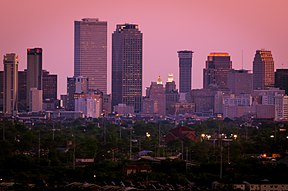New Orleans
New Orleans is a city in Louisiana, which is a state in the United States.
New Orleans
La Nouvelle-Orléans (French) | |
|---|---|
| City of New Orleans | |
| Nickname(s): "The Crescent City", "The Big Easy", "The City That Care Forgot", "NOLA", "The City of Yes", "Hollywood South" | |
 Interactive map of New Orleans | |
| Coordinates: 29°57′N 90°05′W / 29.95°N 90.08°W | |
| Country | United States |
| State | Louisiana |
| Parish | Orleans |
| Founded | 1718 |
| Named for | Philippe II, Duke of Orléans (1674–1723) |
| Government | |
| • Type | Mayor–council |
| • Mayor | LaToya Cantrell (D) |
| • Council | New Orleans City Council |
| Area | |
| • Consolidated city-parish | 349.85 sq mi (906.10 km2) |
| • Land | 169.49 sq mi (438.97 km2) |
| • Water | 180.36 sq mi (467.12 km2) |
| • Metro | 3,755.2 sq mi (9,726.6 km2) |
| Elevation | −6.5 to 20 ft (−2 to 6 m) |
| Population | |
| • Consolidated city-parish | 383,997 |
| • Density | 2,266/sq mi (875/km2) |
| • Metro | 1,270,530 (US: 45th) |
| Demonym | New Orleanian |
| Time zone | UTC−6 (CST) |
| • Summer (DST) | UTC−5 (CDT) |
| Area code | 504 |
| FIPS code | 22-55000 |
| GNIS feature ID | 1629985 |
| Interstates | |
| U.S. Highways | |
| State highways | |
| Public transport | New Orleans Regional Transit Authority |
| Primary airport | Louis Armstrong New Orleans International Airport |
| Website | nola.gov |
History
changeThe city began as the capital of Louisiana (New France), part of the first French colonial empire at the mouth of the Mississippi River. It became a territory of the United States when President Thomas Jefferson bought the Louisiana Purchase in 1803. It became one of the world's great seaports. All the land is low, originally just a short vertical distance above sea level. In the last three hundred years, the city has sunk slowly into the marshy soil. Large portions of New Orleans are now below sea level. A system of many pumps, dikes, sea walls, and levees were built.
The Battle of New Orleans was fought here in 1815. The capture of New Orleans in 1863 was an important step in the defeat of the Confederacy in the American Civil War
Over half of the grain that is sent by ship to other countries, comes first by barge through the Port of New Orleans. The grains are grown in the farming states bordering the Mississippi River, the Missouri River, and Ohio Rivers. Much of the crude oil that is made into gasoline and diesel fuel is brought to New Orleans for oil refinery and distribution to other parts of the United States by barge or oil pipeline. Also, there are many oil well platforms nearby, in the Gulf of Mexico.
Hurricane Katrina
changeOn August 29, 2005, New Orleans was affected by Hurricane Katrina. The special systems built to protect the city failed in several ways. It is estimated that more than three quarters (3/4) of New Orleans was under water in early September 2005. Sewer, phone, electric and fresh water systems failed. Many people drowned. Many homes were completely covered with water. Important records, some from the French period of the 18th century were destroyed.
For years, many people believed that a flood in New Orleans would happen. A very serious flood happened several hundred miles upstream, on the Mississippi Delta, when heavy rains fell in 1927. The hardships from that flood led many people to move away. Many moved to Chicago.
After Hurricane Katrina, many people who lived in the flooded city moved to other places in the US. Many people were afraid to move back. Their jobs and homes were gone and their possessions were lost. The people who could move back spread to many other states. Texas received the most flood victims. Many volunteers and charities are helping the flood victims to relocate to new homes and, at the same time, repair homes and services in this city. Several years after Katrina, New Orleans still had much fewer people than it did before the hurricane.[3]
Culture
changeNew Orleans has a large African American, Creole and French population. Voodoo, brought by African slaves, is practiced in the city.
New Orleans is known for its French culture, French architecture, Creole and Cajun cuisine such as gumbo and jambalaya, and Mardi Gras.
References
change- ↑ "2020 U.S. Gazetteer Files". United States Census Bureau. Retrieved March 2, 2024.
- ↑ "U.S. Population Totals 2010-2020". United States Census Bureau.
- ↑ Mildenberg, David. "Census shows a far less populous New Orleans". washingtonpost.com. Retrieved February 4, 2011.
Other websites
changeMedia related to New Orleans at Wikimedia Commons








